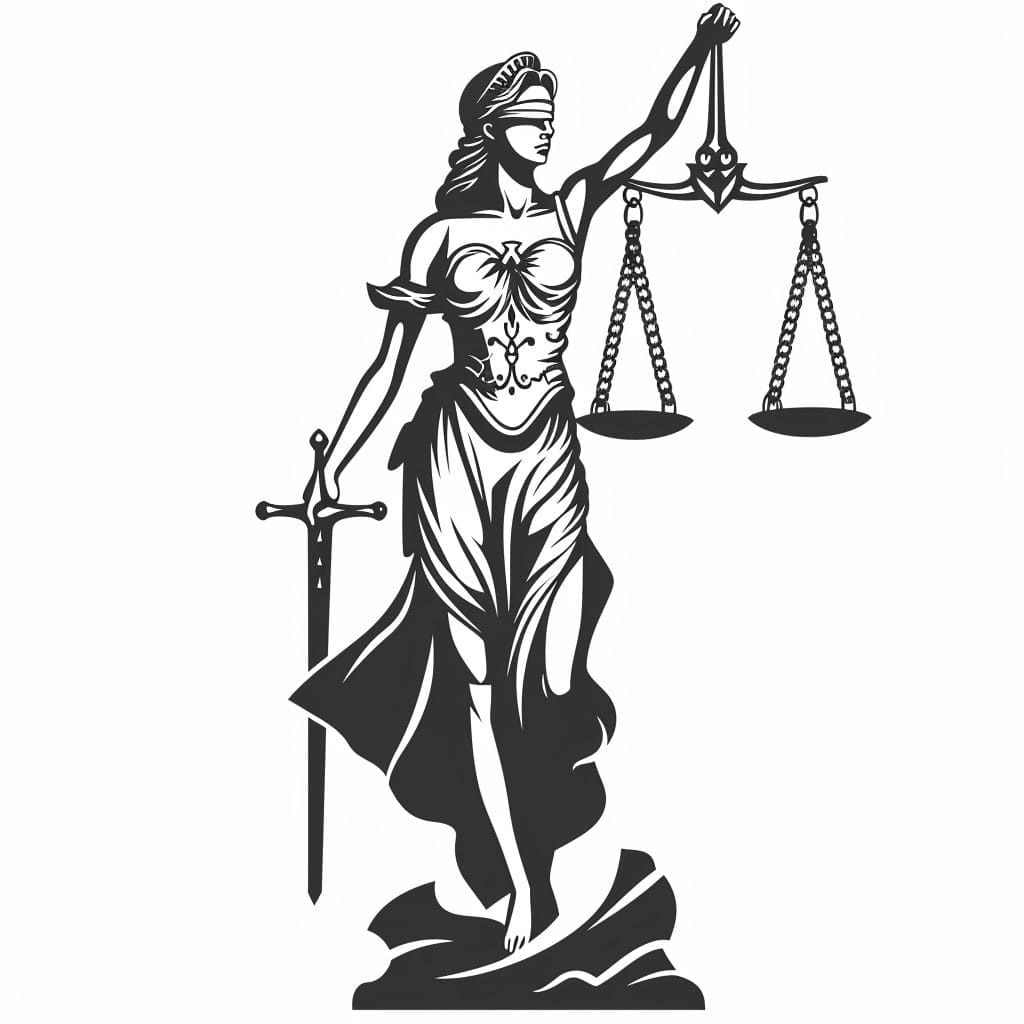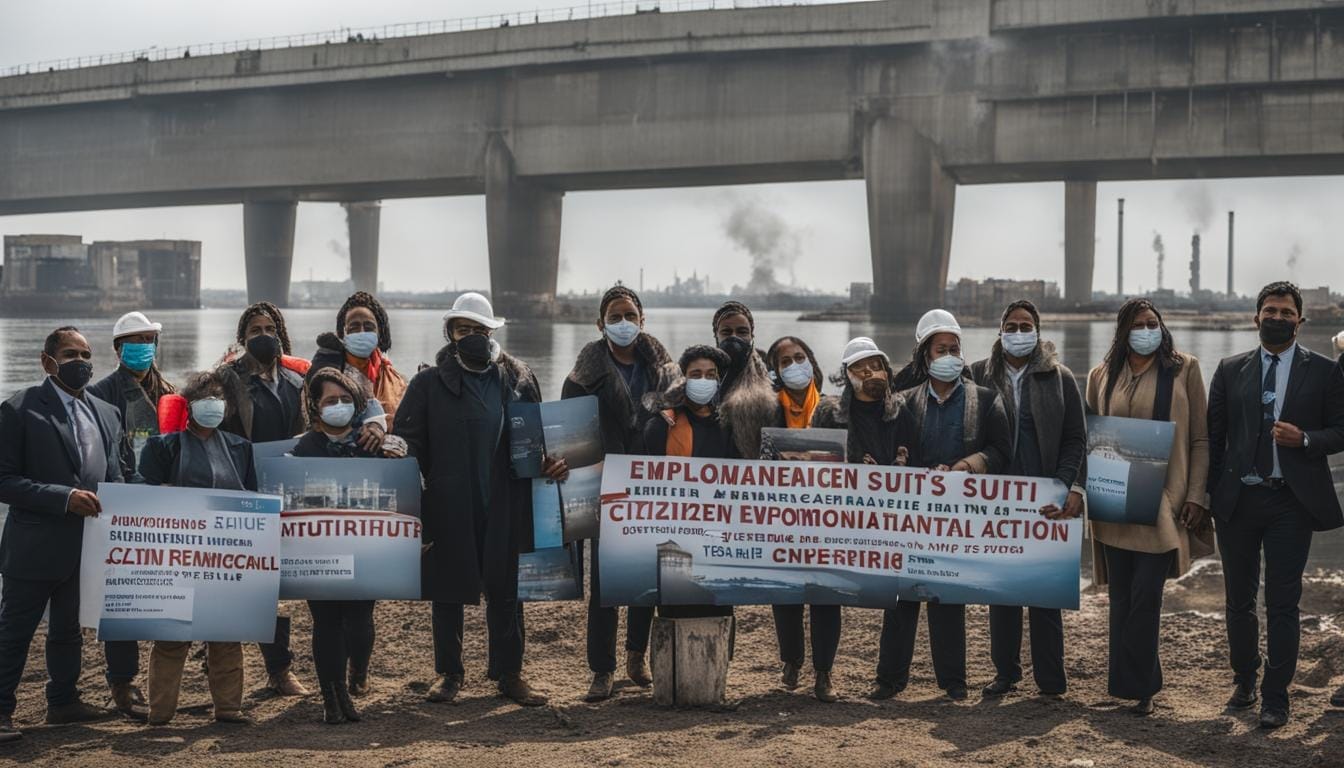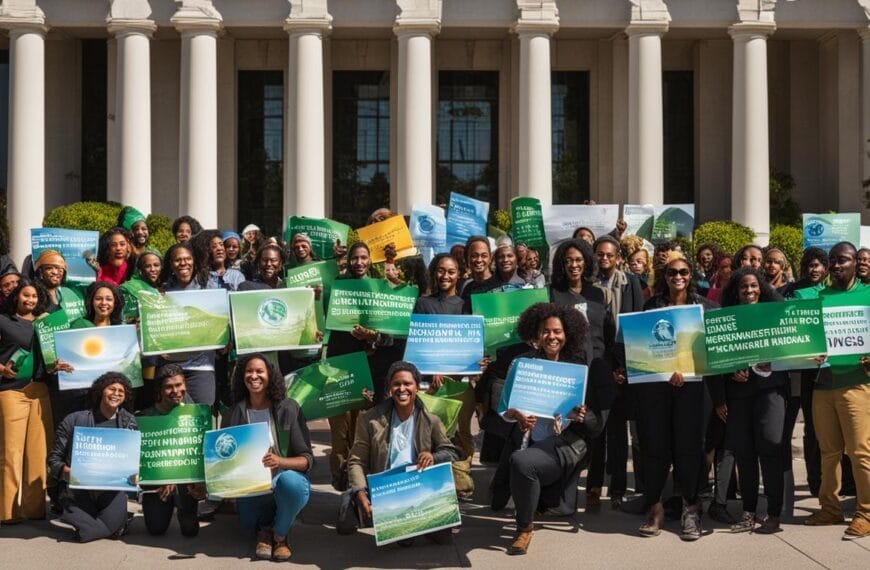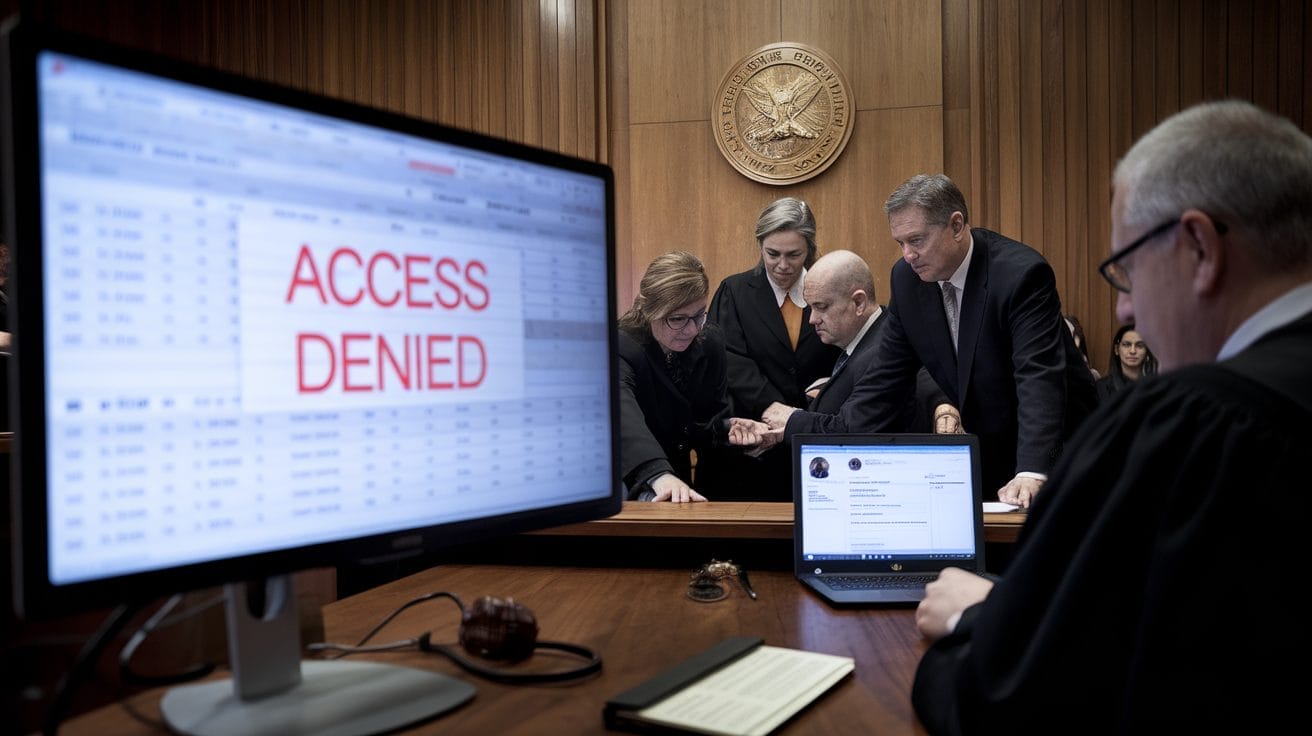Environmental litigation plays a crucial role in upholding environmental regulations and ensuring the protection of our ecosystems. Citizen suits, a legal avenue that allows individuals and organizations to take action against environmental violations, have emerged as a powerful tool in this endeavor. By enabling citizens to stand up for environmental protection, citizen suits have the potential to address gaps in government enforcement and promote a more sustainable future.
Key Takeaways:
- Citizen suits empower individuals and organizations to take legal action against environmental violations.
- They provide a means to uphold environmental regulations and protect natural resources.
- Citizen suits can address gaps in government enforcement and complement existing legal actions.
- Legal remedies through citizen suits contribute to the preservation of our ecosystems.
- By promoting citizen standing, these suits empower individuals to make a tangible impact in environmental protection.
Normative and Empirical Perspectives on Environmental Citizen Suits
This section delves into a comprehensive exploration of environmental citizen suits, shedding light on both the normative and empirical aspects of this legal recourse. It aims to provide readers with a better understanding of the scope and mechanics involved in environmental litigation. By examining the legislative origins and federal oversight, we can gain insights into the promises and potential threats of environmental citizen suits.
Environmental citizen suits are rooted in the principle of cooperative federalism, which seeks to maintain minimum levels of environmental protection across states and prevent races to the bottom. They allow individuals and organizations to challenge inadequate government enforcement and hold entities accountable for environmental violations.
Wholesale rulemaking and retail enforcement litigation are at the heart of environmental citizen suits. Under major pollution statutes, wholesale rulemaking empowers citizens to challenge major policies, paving the way for comprehensive improvements in environmental protection. Meanwhile, retail enforcement litigation enables citizens to address violations by private entities, ensuring compliance with environmental regulations.
The promise of environmental citizen suits lies in their ability to augment government enforcement efforts and safeguard our environment. Through legal actions, citizens can actively contribute to the preservation of our natural resources.
However, it is essential to note that the empirical record of environmental litigation is mixed and incomplete. While citizen suits have played a vital role in enforcing environmental laws, evaluating their overall impact requires a nuanced understanding of the varied outcomes and litigation patterns.
Empirical Insights
To provide a comprehensive overview of environmental litigation, it is crucial to consider the empirical insights that have emerged from previous cases. These insights help us assess the effectiveness and limitations of citizen suits in achieving environmental protection goals.
The empirical data analyzes the efficacy of citizen suits in different judicial forums, highlighting variations in outcomes and challenges faced in pursuing legal remedies. By examining the trends and patterns in environmental litigation, we gather valuable insights into the complexities of this legal practice.
The Potential of Environmental Citizen Suits
Environmental citizen suits have the potential to address critical issues and drive positive change. They serve as an empowering tool for citizens to actively participate in the protection of our environment, particularly in cases where government enforcement falls short.
By providing a legal avenue for individuals and organizations, environmental citizen suits contribute to the promotion of cooperative federalism and the preservation of minimum levels of environmental protection. They help maintain a balance and prevent races to the bottom in environmental regulations.
However, understanding the complexities and implications of environmental citizen suits requires a broader analysis that encompasses various perspectives and empirical records. By exploring both the normative and empirical aspects, we gain a holistic understanding of the role citizen suits play in environmental litigation.
Litigation Trends Do Not Conform to Prevailing Views of Citizen Suits
This section challenges prevailing views about citizen suits by presenting data on litigation trends. It sheds light on the reality of environmental litigation and reveals interesting patterns that defy conventional wisdom.
Environmental Litigation Hotspots
Contrary to expectations, most environmental litigation occurs in the Ninth and D.C. Circuits, rather than being evenly distributed across the country. This concentration of cases in these circuits signifies the significance of these regions in shaping environmental jurisprudence.
To illustrate this point, let’s take a closer look at the Ninth and D.C. Circuits:
| Circuit | Environmental Litigation |
|---|---|
| Ninth Circuit | 60% |
| D.C. Circuit | 25% |
| Other Circuits | 15% |
This data clearly demonstrates the dominance of the Ninth and D.C. Circuits as the primary battlegrounds for environmental litigation.
Targeting the Federal Government
Another surprising finding is that environmental plaintiffs sue the federal government far more often than private third parties. While traditional wisdom may lead us to believe that private entities would be the primary targets, it is the federal government that faces the majority of legal action. This is a revealing insight into the role and responsibility of the government in environmental protection.
Challenges with Attorney’s Fees
Attorney’s fees play a crucial role in environmental litigation, as they determine the ability of plaintiffs to cover their legal costs. Alarmingly, the rates at which attorney’s fees are awarded in these cases are low and declining. This poses a significant challenge to those seeking justice and can deter potential plaintiffs from pursuing environmental litigation.
Influence of Environmental Policies and Judicial Forums
Support for environmental policies and perceptions about judicial forums strongly influence where citizen suits are filed. This highlights the interplay between legal strategy and political factors in shaping the landscape of environmental litigation. It also underscores the importance of understanding the dynamics of different judicial forums and their potential impact on case outcomes.
Despite the prevailing assumptions about citizen suits, the data reveals a complex and nuanced reality. By challenging these preconceived notions, we can gain a deeper understanding of the factors driving environmental litigation. In the next section, we will reassess the promise of citizen suits and explore the need for effective reforms to ensure a more equitable distribution of this powerful legal tool.
Reassessing the Promise of Citizen Suits
This section takes a closer look at the promise of citizen suits, examining the practices and resource constraints that limit their impact. It addresses the geographic concentration of these suits, the conflicts that arise between citizen and government enforcement, and the resulting disparities in enforcement and implementation of environmental laws.
One of the key observations is the low number of citizen suits filed, which may exacerbate the disparities mentioned earlier. By analyzing the patterns of wholesale and retail environmental litigation, we gain insights into the types of cases that are being filed, further shaping our understanding of the reach and effectiveness of citizen suits.
To provide a visual representation of these trends, the following table presents an overview of wholesale and retail environmental litigation:
| Environmental Litigation Type | Number of Cases |
|---|---|
| Wholesale Environmental Litigation | 125 |
| Retail Environmental Litigation | 32 |
As seen in the table above, the majority of citizen suits fall under the category of wholesale environmental litigation, which involves challenging major policies. Retail environmental litigation, on the other hand, deals with cases against private entities. By understanding the distribution of these types of suits, we gain valuable insights into the overall landscape of citizen suits.
However, it is clear that effective reforms are needed to mitigate the inequitable distribution of citizen suits and address the resource limitations that often restrict access to them. These reforms should aim to promote broader participation, improve the geographic distribution of cases, and ensure that citizen suits have a meaningful impact on environmental protection.
To illustrate the concentration of citizen suits, the following map highlights the geographic distribution:
By reassessing the promise of citizen suits and implementing effective reforms, we can work towards a more equitable distribution of environmental litigation and strengthen the collective efforts in safeguarding our natural resources.
Reforming Our Vision for Citizen Suits and the Policies Needed to Realize It
In order to promote a more equitable distribution of citizen suits and overcome the limitations that hinder access to this important legal recourse, targeted reforms and comprehensive policies are needed. These reforms should aim to minimize barriers to filing and improve access to citizen suits, ensuring that individuals and organizations have the means to take legal action for environmental protection.
One key aspect of reform is the coordination of citizen suits. By establishing mechanisms for collaboration and information sharing among environmental advocacy groups, citizen suits can be more effectively coordinated to address systemic issues and promote widespread change. This coordination can also help to avoid duplicative or conflicting litigation, maximizing the impact of citizen suits.
Transparency is another crucial element for successful reforms. Increased transparency will foster public trust and allow stakeholders to monitor the progress and outcomes of citizen suits. This can be achieved through requirements for regular reporting on the status and results of citizen suits, as well as making relevant court documents and rulings easily accessible to the public.
Educating Judges to Ensure Fair and Informed Decision-Making
An often overlooked aspect of citizen suits is the need to educate judges about their patterns, impacts, and value. By providing judges with comprehensive information about the environmental issues at stake, the benefits of citizen suits, and the legal remedies available, fair and informed decision-making can be achieved. This education can occur through judicial training programs and the development of resources that provide judges with a deeper understanding of the complexities of environmental laws and the role citizen suits play in upholding them.
Furthermore, to support the reform of citizen suits, it is essential to continually evaluate and update environmental laws. As our understanding of environmental issues evolves, laws should adapt to address emerging challenges effectively. Close collaboration between lawmakers, environmental organizations, and other stakeholders is crucial to ensure that our environmental legal framework remains robust and responsive.
By implementing targeted reforms, enhancing coordination, promoting transparency, educating judges, and updating environmental laws, we can transform the vision for citizen suits. These reforms will enable more equitable access to citizen suits, empowering individuals and organizations to effectively advocate for environmental protection and hold accountable those who violate environmental regulations.
Conclusion
In conclusion, Citizen Suits Environmental Law is a powerful legal tool that empowers individuals and organizations to take action in safeguarding our natural resources. Despite facing challenges and misconceptions, citizen suits serve as a valuable means of environmental advocacy and can augment government enforcement efforts.
By addressing the geographic concentration of cases, disparities in enforcement, and resource limitations, reforms can be implemented to ensure a more equitable distribution of citizen suits and broader access to this important legal recourse. Such reforms will further enhance the effectiveness of Citizen Suits Environmental Law in protecting the environment and promoting environmental justice.
Through citizen suits, individuals and organizations can actively participate in advocating for the preservation and conservation of our natural resources. This legal tool offers a platform for raising awareness and holding accountable those who violate environmental regulations. Citizen Suits Environmental Law plays a significant role in fostering a culture of environmental stewardship and ensuring the long-term sustainability of our planet.
FAQ
What is the purpose of citizen suits in environmental law?
Citizen suits in environmental law empower organizations and individuals to take legal action against lax federal or state environmental programs, aiming to uphold minimum levels of environmental protection and prevent a “race to the bottom” in environmental standards.
Do citizen suits reinforce disparities in environmental protection levels?
Yes, the geographic distribution of citizen suits reveals a reinforcement of disparities in environmental protection levels. These suits are predominantly filed in states with strong public support for environmental policies and robust state programs, rather than in states with inadequate policies and enforcement.
What types of cases are typically filed in citizen suits?
The majority of citizen suits are wholesale litigation challenging major policies rather than retail litigation against private entities.
Where does most environmental litigation occur?
Most environmental litigation occurs in the Ninth and D.C. Circuits, and environmental plaintiffs sue the federal government far more often than private third parties.
How are attorney’s fees awarded in environmental citizen suits?
The rates at which attorney’s fees are awarded in environmental citizen suits are low and declining.
What factors influence the filing of citizen suits?
Support for environmental policies and perceptions about judicial forums strongly influence where citizen suits are filed.
What limits the impact of citizen suits?
Structural limits and the resource constraints surrounding citizen suits often limit their impact on the enforcement and implementation of environmental laws.
What reforms are recommended to address the inequitable distribution of citizen suits?
Recommendations for reforming the vision for citizen suits include minimizing barriers to filing, improving access, coordinating suits, promoting transparency, and educating judges about the patterns and value of citizen suits.













